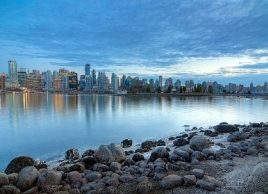Canada’s bluest communities
Best Health recognizes five communities that are doing extraordinary things in water conservation, treatment and safety

Source: Best Health Magazine, October 2008
Water, water everywhere—this country has more fresh water per capita than any other in the world. And it’s a given that it’s generally clean. But are we taking too much for granted? “Water quality is undervalued in terms of its importance to community health,” says Bernadette Conant, director of programs for the Canadian Water Network, located at the University of Waterloo. She says the people responsible for ensuring the cleanliness of our drinking water—essential, of course, to good health—are “some of our most important public health workers.”
Indeed, Environment Canada says that, based on an extrapolation of U.S. estimates, as many as 90 Canadians die and 90,000 become ill each year because of drinking water contaminated with pathogens. Some experts say the actual number of cases could be 10 to 1,000 times higher.
We’re not doing brilliantly at water conservation, either. In a study by the David Suzuki Foundation that examined industrialized member states of the Organization for Economic Co-operation and Development (OECD), Canada placed second-to-last (ahead only of the U.S.) out of 30 in water conservation per capita. Canadians, the report noted, consume 10 times more water than the citizens of Denmark (who placed first), and more than double the OECD average. And in municipal sewage treatment, we placed 14th out of 28 industrialized nations. “Sewage treatment isn’t only about the health of the environment and maintaining appealing waterways,” notes Conant. “Because discharges from one community often flow into the same watercourse accessed by water intakes for another downstream, it’s also linked to clean drinking water.”
But the news isn’t all bad. Many communities are working hard at improving conservation and treatment. After speaking with national water experts, Best Health chose five jurisdictions that deserve special recognition for setting the bar high. These are Canada’s Bluest Communities.
Halifax: For decades, Halifax has sent tons of raw sewage into its harbour, one of the world’s largest. But now, the city is taking major steps to clean it up. Read more
Okotoks, Alta.: Facing exploding growth (Calgary, one of Canada’s fastest growing cities, is just 20 minutes north) and limited water resources, Okotoks took a rare step: It capped the population at 30,000, the most the town’s water source, the Sheep River, can support. Read more
Toronto: The mayor of Toronto has pledged to make Canada’s largest city the most environmentally friendly on the continent, and that green dedication extends to its water. Under a plan approved by city council in 2003, the city is investing more than $1 billion over 25 years to improve water quality along its waterfront and rivers. Read more
Chelsea, Que.: This town of 7,000 is a national leader in groundwater management among rural areas and smaller centres. Read more
Edmonton: Although Alberta’s oil sands are frequently cited as a blot on Canada’s green image, Edmonton’s drainage utility is making part of the process much more environmentally sound. Read more
Other "Blue" Canadian Communities
- B.C.’s Sunshine Coast Regional District: The district, which includes the communities of Sechelt and Gibsons, is offering to replace residents’ old bathroom fixtures with a package of up to two dual-flush toilets (which allow users to choose between a small or larger flush), high-efficiency shower heads and faucet aerators—at no charge, installation included.
- Calgary, Alta.: The booming city has one of the nation’s best water-efficiency programs. Initiatives include technology rebate programs, educational campaigns and repairing leaks in the distribution system.
- Guelph, Ont.: In the past few years, this city in southern Ontario has partnered with local home builders and the University of Guelph’s engineering school to explore residential rainwater harvesting systems, which could reduce a family’s water consumption by as much as 50 percent.
Found this article informative? Subscribe to our magazine today and receive more Best Health exclusives delivered to your door!




